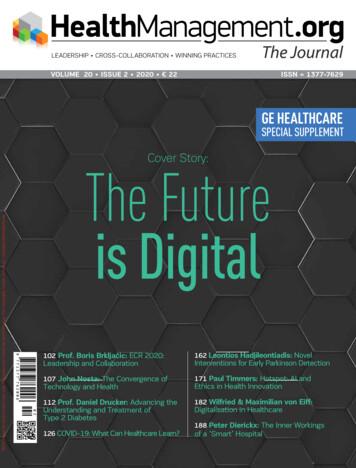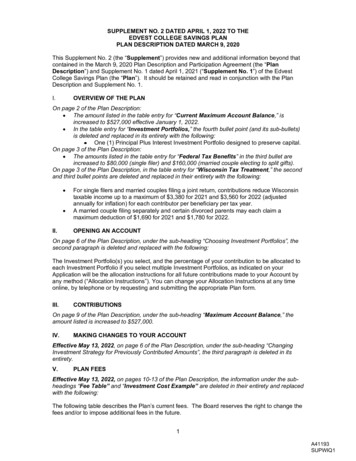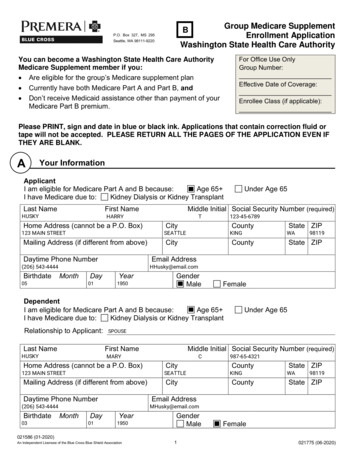
Transcription
Leadership Cross-Collaboration Winning PracticesVOLUME 20 ISSUE 2 2020 22ISSN 1377-7629GE HEALTHCARESPECIAL SUPPLEMENT For personal and private use only. Reproduction must be permitted by the copyright holder. Email to copyright@mindbyte.eu.Cover Story:The Futureis Digital102 Prof. Boris Brkljačic: ECR 2020:162 Leontios Hadjileontiadis: NovelInterventions for Early Parkinson Detection107 John Nosta: The Convergence ofTechnology and Health171 Paul Timmers: Hotspot: AI and112 Prof. Daniel Drucker: Advancing the182 Wilfried & Maximilian von Eiff:Leadership and CollaborationEthics in Health InnovationUnderstanding and Treatment ofType 2 DiabetesDigitalisation in Healthcare126 COVID-19: What Can Healthcare Learn?of a ‘Smart’ Hospital188 Peter Dierickx: The Inner Workings
Cover StoryThe Future is DigitalNew Catalonian Digital HealthStrategy: A PresentationSummary: The Digital Health Strategy for Catalonia(Spain) is one of the current few ambitious initiatives ofhealth information systems’ transformation in Europe. For personal and private use only. Reproduction must be permitted by the copyright holder. Email to copyright@mindbyte.eu.Similar to other developed countries around the world, thepublic health system of Catalonia is subject to tensions,challenges and opportunities that mainly result from anageing population, rising operational costs, incorporation of new technologies and medical treatments, laboursupply changes, the ever-increasing demand for high qualitypatient care, as well as a higher level of knowledge anddemand on the part of citizens (Rossini and Marra 2014;Majchrzak et al. 2016). Within this scenario, a topic thatemerges strongly is the transforming role of data management and information technologies (IT) for the empow-(Kothari et al. 2011).Locally, the Health Plan is the strategic, interdisciplinaryand collaborative framework that guides the actions of allstakeholders within the Catalonian healthcare system inorder to improve the quality of life and the wellbeing of thepopulation, the access to and resolution of health services,and the efficiency and sustainability of the system as awhole.The Digital Health Strategy for Catalonia (Departamentde Salut 2017) is designed to achieve the goals as definedby the Health Plan (Directorate General for Health Plan-The current model has generated great diversity of systems thatresults in high maintenance, licencing and evolution costs, whichimpacts both transactional and departmental solutionserment of the patient, improved healthcare practice andmanagement, and better allocation of resources (Kudyba2010).Healthcare has been identified as one of the sectors withthe greatest potential for the intelligent use of data. At theoperational level, it allows clinicians to share patient healthinformation throughout different healthcare stances. At themanagement level, it facilitates transparency and comparability reducing the variability of healthcare practice andincreasing the quality and security of care, and enablesregulators, insurance companies and service buyers toestablish contracts and economic conditions. At the analytical level, it is an opportunity to research new treatments,services and products that fulfil the promise of personalisedand predictive medicine. In all cases, it provides patientswith access to their data and information and modifiestheir relationship with professionals and health system(Davenport and McNeill 2013). Healthcare is an informationindustry where information and knowledge play a key role158ning 2016). As a matter of fact, it is not just a technologyupdate, but a framework for the management of the dataand for architecture of the information systems that corresponds to and, in some cases, anticipates the changestaking place in the care model with regard to citizen relations with the health system, in the work processes andin the relationships between professionals. Hence, itsapproach is systemic, meaning it covers the exchange ofdata among the various healthcare services and even withother areas, such as social services, and consequentlyaffects the tools used by the care providers. Also, for thisreason it provides instruments to intensify collaborationbetween different actors, define semantic and technicalstandards and share and take advantage of technologicalinnovation.The design of the Digital Health Strategy for Catalonia,now being executed, was developed in the course of oneyear (March 2017 – February 2018) by executives and ITmanagers of the Catalonian Ministry of Health and careHealthManagement.org The Journal Volume 20 Issue 2 2020
Cover StoryThe Future is Digitalproviders, as well as clinicians and experts in health andcare management and planning. The Digital Health Strategywas conceived as a comprehensive exercise with the aim oftaking into account the opinions of all the stakeholders whoform the Catalonian healthcare system. It was also enrichedwith an analysis of experiences from the international landscape. In total, almost 300 people took part in the projectthrough different mechanisms. For personal and private use only. Reproduction must be permitted by the copyright holder. Email to copyright@mindbyte.eu.Current SituationSpain has a statutory national health system (Beveridgemodel), which is characterised by universal coverage andfunded by the government through tax payments. Servicesare largely provided free of charge at the point of carewhereas most pharmaceuticals prescribed require aco-payment. There are 17 regional health ministries acrossSpain, each having political control and jurisdiction overthe organisation and delivery of health services within theirrespective regions.In Catalonia, the Department of Health is the ultimateauthority for the definition and planning of healthcareservices in Catalonia. The Catalan Service of Health acts asthe purchaser of services and guarantees quality control. Atthe supply side, the Catalan healthcare system is ensuredby an integrated multi-provider public network. Currently,this network comprises 71 hospitals, 369 primary carecentres, 96 intermediate care centres, 41 mental healthfacilities and 422 resources of emergency transportationand other services (rehabilitation, community mental healthcentres, etc).Even though healthcare providers are free to select theirinformation systems and interoperability among differentsoftware, 98% of the primary care centres rely on the samesystem. Unfortunately, there are also some drawbacks,such as the high heterogeneity of information systemsin specialised care where 29 different systems coexist,which means substantial technical complexity is needed toachieve interoperability among them.The Catalan healthcare system, from an IT point of view,successfully completed what could be considered as thefirst wave of digitalisation. This initial phase consisted ofincorporating IT within the care providers with the aim ofsupporting the work of professionals, namely in clinicalworkstations and, in large part, nursing, both in primary careand in hospitals, some departmental systems and enterprise infrastructure systems (ERP).From an economic point of view, the current modelhas generated great diversity of systems that results inhigh maintenance, licencing and evolution costs, whichimpacts both transactional and departmental solutions.Local capacities of providers, especially during the recenteconomic recession, have also been seriously limited.Therefore, it was necessary for the Catalonian healthcare system to urgently advance its information servicesand technologies, both quantitatively and qualitatively, inorder to build a person-centred information system. Sucha system would facilitate the continuous tracking of citizens and patients and be compatible with the professionalor the provider dealing with them at a specific time. Thisnew model should offer all the actors common and meaningful information that is relevant and of quality, and easyto record, access and analyse if needed. The managementof the data and the proposed technological scheme shouldmake possible the extension of new care models, allow theautomation of bureaucratic tasks, and facilitate patients’access to their information and interaction with the system.Key Features of the New information SystemModelThe longitudinal Electronic Health Record (EHR) is the mainfeature of the Digital Health Strategy. It represents thefunctional and technical repository of all the relevant information on a certain citizen that must be recorded andshared throughout the healthcare system. It is a conceptual and technological evolution of the medical recordsthat are currently used in the systems of different serviceproviders. A common health record scheme must take intoaccount and align process components (how to make andregister events and the route of a citizen through the healthsystem), data components (a shared structure and nomenclature) and a technological model (how data are recorded,stored and transmitted).Sharing more and more quality data will make it possibleto interrogate and analyse large volumes of information,compare risk factors and different practices and treatments, return the results to patients, professionals andFigure 1. A Simplified View of the Electronic Health Record Model as Defined in the Digital Health Strategy for Catalonia.HealthManagement.org The Journal Volume 20 Issue 2 2020159
Cover Story For personal and private use only. Reproduction must be permitted by the copyright holder. Email to copyright@mindbyte.eu.healthcare managers, improve decision-making and furthermove towards predictive and personalised medicine. Thestrategic plan foresees the construction of an advancedanalytical repository for the treatment of structured andunstructured data (text, image, electromedicine devices andwearables).The EHR also has the potential to become an integralinformation system that may provide value-added servicesto the care providers that need or wish to evolve or transform their current systems. Some of the existing systems,such as the main primary care medical record, deserve aprofound technological update exercise. This update is alsoa good opportunity to create an integrated citizen datamodel that considers the vision of the individual healthstatus together with the logic of acute episodes, regardlessof where they occur. In this way, the primary care databasewill become the nucleus of the central data repository, withwhich it will be integrated naturally.This model (‘coordinated‘ technologically and ’participated’ in its governance) (Weill and Ross 2004) is wellaligned with a health model that needs to share information and is integrating healthcare services in a region, whilemaintaining the institutional autonomy of service providersto design their organisational processes and structures. Thenew technological solutions present in the market, moremodular and uncoupled and easier to integrate, facilitatethese design options.The introduction of the longitudinal EHR can be considered the second wave of digitalisation, similar to thosebeing recently tackled by other international healthsystems, both vertically integrated (ie where the regulatorand planner is also the owner of the service provider entities) and those where different types of providers coexist.In many cases, diversified systems facilitate greater adaptation to the way each entity works and encourage localThe Future is Digitalinnovation. The healthcare sector, including the one ofCatalonia, has been a pioneer in creation and applicationof digital transformation technologies, particularly in thefield of telemedicine. Despite that, a set of factors havehampered the extension and generalisation of many valuable projects.The strategic plan faces this status and facilitates acooperative environment in order to foster, evaluate andextend innovation. The main objective is to provide the critical mass and the necessary economic dimension to allowthe growth and use of innovation throughout the system,especially those technologies that help to redesign careprocesses, deploy new ones and develop the new EHR.This is the case with the Big Data initiatives, eHealth andmobility, the Internet of Things and Artificial Intelligence.GovernanceTo guarantee the success of the Digital Health Strategy, agovernance model of information systems is being implemented combining both executive and regulatory leadership with the participation and advice of the supplier entities, as well as the creation of communities of practice forthe development of innovation.The governance model is designed with ambition to position the Catalan health system at the level of the mostadvanced organisations in terms of management of dataand technologies. These organisations acknowledge thestrategic role of information systems in supporting andtransforming their work processes and rely on data tomake decisions all along the care continuum. Normally, thisrecognition is associated with a corporate governance ofinformation systems, a stable and recognised management body, a top-level management role of its managersand adequate allocation of economic, technical and humanresources.Figure 2. The 15 Strategic Initiatives of the Digital Health Strategy for Catalonia Grouped in 5Key Dimensions.160HealthManagement.org The Journal Volume 20 Issue 2 2020
Cover StoryThe Future is DigitalIn order for the strategic plan to be effective and credible,a specific funding mechanism is being processed now atthe government level. The financing of investments in technology will have to be sufficient to achieve the objectives ofthe plan, sustainable over time and include incentives thatfavour the renovation of the technology park and its alignment with the proposed information model.For the implementation of the strategy, an ambitious,but flexible and realistic executive programme has beenestablished with the aim to simultaneously work on strategic projects that leverage change and improvements inprojects and current services to make them converge withthe future model, and in immediate actions and decisions,including the removal of services and circuits that do notprovide value. In the short term, the aim of construction andinitial launch of the central data repository is to make theinformation from different sources, currently stored in thesystem, available to the community.Author: Jordi Piera JiménezSenior Director Health Information & Innovation, American HealthInformation Management Association Badalona Spainjordi.piera@ahima.org @jpierajAuthor: José Ramón RodríguezLecturer and Researcher on Management of Information Systems,Universitat Oberta de Catalunya Barcelona Spainjrodriguezber@uoc.eduAuthor: Pol Pérez SustManaging Director (CIO), Catalan Health Service Barcelona Spainpolperezsust@gencat.catKey Points Strategic planning in the public sector is alwayscomplex. In the highly fragmented and politicisedCatalonian landscape the effort is enormous. Multiple stakeholders (more than 300 managers, ITspecialists and clinicians) took part in the design,through different mechanisms. Unlike other information systems’ strategic plans, whichare based on the automation of processes, this plan isfully data centric. The strategic plan aims to syntactically, semanticallyand technically unify the data model by building a singlelongitudinal Electronic Health Record. The plan aims to develop a common data repositoryand analytical services following a ‘data lakehouse’approach. The Digital Health Strategy for Catalonia aims to setup a backbone to build upon advanced digital services,emerging technologies and innovation. Governance is crucial: find a balance between executivedirection and industry involvement and participation. For personal and private use only. Reproduction must be permitted by the copyright holder. Email to copyright@mindbyte.eu.ConclusionToday, more than ever, the so-called ‘digital transformation‘(Bharadwaj et al. 2013) means convergence between business and organisational strategies and technology strategy,where the contribution of information technology is clearerfor the creation of value.Information technologies enable different actors in thesystem to optimise processes and provide much morepersonalised and effective care. The fusion between healthcare and information technology is transforming the qualityof the patient experience at a rate previously unthinkable.Health systems are undergoing unprecedented changesthat seek to improve quality of care and maintain costswhile addressing the challenges of the ageing population and the subsequent increase in chronic diseases,global financial crises, the reduction in public spendingand the increase in operational costs. In this environment,digital tools and services can help to solve these problemsby offering more sustainable, patient-centred solutions.Changes are massive, and the only way to success is properinformation systems’ strategic planning and governance.ReferencesBharadwaj A et al. (2013) Digital BusinessStrategy: Toward a Next Generation ofInsights. MIS Quarterly, 37(2):471–482.Davenport TH, McNeill D (2013) Analytics inHealthcare and the Life Sciences: Strategies,Implementation Methods, and Best Practices.London: Pearson Education (FT PressAnalytics).Departament de Salut (2017) Pla Director deSistemes d’Informació del SISCAT. Availablefrom iii.hm/118preview. Ontario (Canada): BMC Health ServRes.Directorate General for Health Planning(2016) Health Planfor Catalonia 2016-2020.A Person-Centred System: Public, Universaland Fair. Available from iii.hm/118qKudyba S (2010) Healthcare Informatics.Boca Raton: CRC Press.Kothari A et al. (2011) Lessons from thebusiness sector for successful knowledgemanagement in health care: a systematicMajchrzak A, Lynne Markus M, Wareham J(2016) Designing for digital transformation:Lessons for information systems researchfrom the study of ICT and societal challenges.MIS Quarterly: Management InformationSystems, 40(2):267–277.Rossini PM, Marra C (2014) DemographicChanges and the Challenge for a HealthyAgeing. Studies in Health Technology andInformatics, 203:23–31.Weill P, Ross J (2004) IT Governance: HowTop Performers Manage IT Decision Rightsfor Superior Results. Brighton (MA): HarvardBusiness School Press.HealthManagement.org The Journal Volume 20 Issue 2 2020161
regulators, insurance companies and service buyers to establish contracts and economic conditions. at the analyt-ical level, it is an opportunity to research new treatments, services and products that fulfil the promise of personalised and predictive medicine. in all cases, it provides patients










